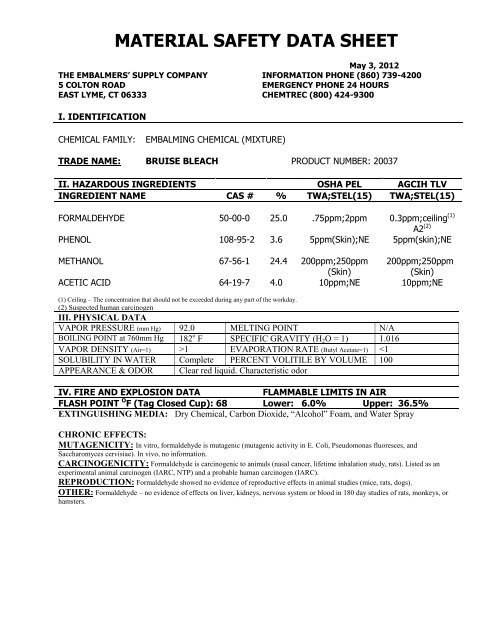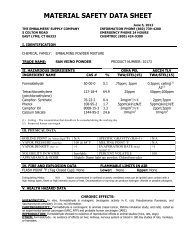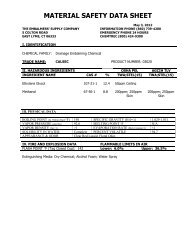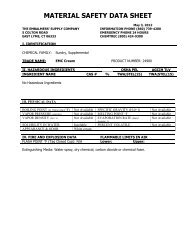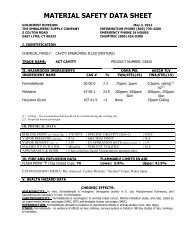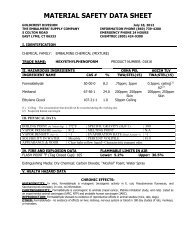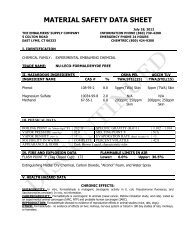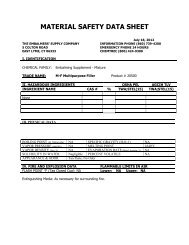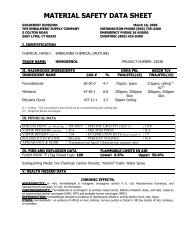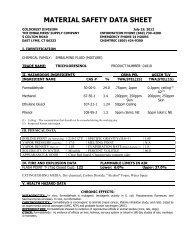Bruise Bleach - Embalming Supply Company
Bruise Bleach - Embalming Supply Company
Bruise Bleach - Embalming Supply Company
Create successful ePaper yourself
Turn your PDF publications into a flip-book with our unique Google optimized e-Paper software.
MATERIAL SAFETY DATA SHEET<br />
May 3, 2012<br />
THE EMBALMERS’ SUPPLY COMPANY INFORMATION PHONE (860) 739-4200<br />
5 COLTON ROAD EMERGENCY PHONE 24 HOURS<br />
EAST LYME, CT 06333 CHEMTREC (800) 424-9300<br />
I. IDENTIFICATION<br />
CHEMICAL FAMILY:<br />
EMBALMING CHEMICAL (MIXTURE)<br />
TRADE NAME: BRUISE BLEACH PRODUCT NUMBER: 20037<br />
II. HAZARDOUS INGREDIENTS OSHA PEL AGCIH TLV<br />
INGREDIENT NAME CAS # % TWA;STEL(15) TWA;STEL(15)<br />
FORMALDEHYDE 50-00-0 25.0 .75ppm;2ppm 0.3ppm;ceiling (1)<br />
A2 (2)<br />
PHENOL 108-95-2 3.6 5ppm(Skin);NE 5ppm(skin);NE<br />
METHANOL 67-56-1 24.4 200ppm;250ppm 200ppm;250ppm<br />
(Skin)<br />
(Skin)<br />
ACETIC ACID 64-19-7 4.0 10ppm;NE 10ppm;NE<br />
(1) Ceiling – The concentration that should not be exceeded during any part of the workday.<br />
(2) Suspected human carcinogen<br />
III. PHYSICAL DATA<br />
VAPOR PRESSURE (mm Hg) 92.0 MELTING POINT N/A<br />
BOILING POINT at 760mm Hg 182 o F SPECIFIC GRAVITY (H 2 O = 1) 1.016<br />
VAPOR DENSITY (Air=1) >1 EVAPORATION RATE (Butyl Acetate=1)
V. HEALTH HAZARD DATA<br />
Effects of Exposure<br />
EYE CONTACT: Vapor causes sever irritation and tearing. Contact with<br />
liquid causes severe burns.<br />
SKNI CONTACT: Liquid causes drying, cracking and scaling. Repeated<br />
contact causes hardening of the skin and may cause dermatitis and<br />
sensitization.<br />
INHALATION: Causes irritation to nose, throat and respiratory tract.<br />
Bronchopneumonia and edema possible from breathing high concentrations.<br />
INJESTION: May be fatal if swallowed. Severe inflammation of mouth,<br />
throat or stomach. Blurring of vision or blindness may occur.<br />
HMIS RATINGS<br />
HEALTH 2<br />
FIRE 1<br />
REACTIVITY 0<br />
SPECIAL 0<br />
VI.<br />
VII.<br />
EMERGENCY FIRST AID<br />
EYE CONTACT: Immediately flush eyes with plenty of water for at least 15 minutes. Call a physician.<br />
SKIN CONTACT: Immediately flush skin with plenty of water for at least 15 minutes. Remove contaminated<br />
clothing and shoes. Wash clothes before reuse.<br />
INHALATION: Remove to fresh air. If not breathing, give artificial respiration, then oxygen if necessary. Call<br />
a physician.<br />
INGESTION: Induce vomiting immediately by giving two glasses of water and sticking finger down throat.<br />
Never give anything by mouth to an unconscious person. Call a physician.<br />
SPILL AND DISPOSAL INFORMATION<br />
SPILL OR LEAK: Ventilate area thoroughly – avoid breathing vapor. Absorb liquid with inert absorbent<br />
material. Flush area with plenty of water.<br />
WASTE DISPOSAL: Dispose of residue in compliance with Federal, State and Local regulations.<br />
VIII. REACTIVITY DATA: Stability: Product is Stable; YES<br />
Product is Unstable; NO<br />
Materials and conditions to avoid: Caustics and strong oxidizing agents; high temperatures.<br />
Hazardous polymerization: May Occur-- Will Not Occur – X<br />
Hazardous Decomposition Products: Hydrogen, Formaldehyde, Carbon Monoxide, and Carbon Dioxide.<br />
VIII. PROTECTION INFORMATION<br />
Respiratory Protection: Ventilation should be adequate to keep exposure limits below the Action Level (CFR<br />
29 1910.1048) of 0.5 ppm. If limits are exceeded, a full face NIOSH approved respirator should be used.<br />
Ventilation: Local exhaust should be adequate to control exposure.<br />
Eye Protection: Gas proof goggles and face shield recommended.<br />
Protective Gloves: Neoprene, Butyl or Polyvinyl gloves.<br />
IX.<br />
SPECIAL PRECAUIONS<br />
Keep containers closed. Store in a cool, well-ventilated area away from open flame. Do not breathe vapor. Avoid<br />
prolonged or repeated contact with skin. Wash thoroughly with soap and water after handling.<br />
X. This mixture contains toxic chemicals subject to the reporting requirements of section 313 of Title III of the<br />
Superfund Amendments and Reauthorization Act of 1986 and 40 CFR Part 372.<br />
Formaldehyde CAS number 050-00-0 Reportable Quantity 100 pounds<br />
Methanol CAS number 067-56-1 Reportable Quantity 5000 pounds<br />
Phenol CAS number 108-95-2 Reportable Quantity 1000 pounds<br />
While The Embalmers' <strong>Supply</strong> <strong>Company</strong> (ESCO) believes that the data contained herein are factual and believes that the opinions<br />
expressed are those of qualified experts, the data are not to be taken as a warranty or representation for which ESCO assumes legal<br />
responsibility. They are offered solely for your consideration, investigation, and verification. Any use of this data and information must be<br />
determined by the user to be in accordance with applicable Federal, State and local laws and regulations.


